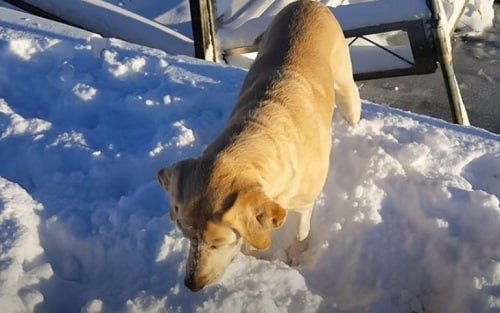If you’ve seen your Labrador Retriever go full tilt into a lake in winter, no one will fault you for thinking that their ever-shedding double coat must keep them warm in winter. Their coats do provide first-line protection from the winter cold, but your Lab does feel the cold when temperatures drop to near freezing, especially if they spend a lot of time outdoors.
Labradors will need jackets in winter as labs can be susceptible to the cold if they spend long hours in temperatures below 20°F or low temperatures with icy rain or winds. Older Labs and puppies can be particularly susceptible to cold climes. The right jacket can help your dog stay warm.
Read on to learn more about when your Lab might need a little help from you to keep warm in winter and how to help them weather the coldest temperatures in good health and spirits.
Table of Contents
Labradors Are Bred for Cold Climates
Labradors are the most popular dog breed in the United States, known for their affection, intelligence, and endlessly wagging tails.
Whether you have a Yellow, Black, Chocolate, or Silver Lab, you know how they shed.
Labs descend from St. John’s dogs, which were bred originally as fishing dogs. Like their ancestors, Labs today have a “double-coat,” made up of a water repellent topcoat over a dense undercoat.
This makes them excellent at venturing in and out of icy waters in the winter months.
Do Labradors Shed in Winter?
Your Lab carries on many of St. John’s dogs’ original traits, including their coats, which molt, or “blow their coat,” twice a year, in Spring and Fall.
While this may be their “heavy” shedding season, Labs are year-round shedders.
To manage the dog hair, vets recommend weekly brushing and monthly bathing.
If you notice your Lab is shedding in unusual amounts, it may be a sign of stress, allergies, a skin condition, fleas, lice, mites, or parasites, and you may want to see your vet.
When Does Your Lab Get Cold?
It’s hard to imagine your Lab gets cold with all that hair and energy, but Labs aren’t bred for constant exposure to cold weather extremes.
To judge how cold it is for your Lab, consider the overall weather conditions and watch your dog’s behavior to see how they’re feeling.
Labs’ cold tolerance varies somewhat based on age, body fat composition, activity level, and health.
In general, when temperatures drop below 35°F (1.7°C), a healthy adult Labrador will start to feel the cold and will become too cold once temperatures dip to 20°F (-6.7°C).
Outdoor temperature is only part of the equation. If your Lab has been walking in the water or the rain, they may be retaining moisture in their coat, which will make them feel the cold more intensely.
Weather conditions such as wind chill, cloud cover, humidity, and your pup’s activity level outdoors all can make your Lab feel colder than the temperature reading alone suggests.
Can Labradors Sleep Outside in Winter?
While most adult Labs do have good protection from the cold and can sleep outside in winter, they can get too cold in freezing temperatures, particularly at night.
They need additional protection when temperatures are below 35°F when winds or rains accompany the cold, and when temperatures dip below 20°F, your Lab may be better off inside.
To help your Lab sleep comfortably outside in the winter, you should:
- Get an insulated or heated dog kennel
- Provide a dog bed, heated blanket
- Provide your Lab with warm food
- Make sure your Lab is well-hydrated
- Brush your Lab’s coat to keep it healthy
- Make your Lab gets enough exercise
How Cold Is Too Cold for a Labrador Puppy?
Labradors rely on body fat to stay warm, but Lab puppies often lack sufficient fat to regulate their temperature well and aren’t well acclimated to cold weather.
It may be best to bring your puppy in freezing weather conditions or if they’re showing signs of a cold.
As you get to know your puppy, you will better understand its behavior, cold tolerance, and limits, but here are some things to watch for that can indicate your puppy is too cold:
- Shaking or shivering
- Barking or whining
- Seeking shelter
- Resisting walking
- Seeming visibly uncomfortable, inactive, or anxious
- Hunching and tucking their tail
- Lifting their paws off the ground
When in doubt, err on the side of caution.
Senior Dogs
Like puppies, elder Labs, and those with medical conditions such as arthritis, which may worsen in the cold, diabetes, heart or kidney disease, or recovering from illness or injury also need extra care in cold temperatures.
You want to be especially vigilant that your Lab of any age does not develop hypothermia or frostbite, particularly on their ears, feet, and tails.
If your Lab shows signs of cold, decrease walk times; dry them off from winter swims and rain, and bring them indoors if they sleep outside. Consider getting them a jacket.
How To Find the Right Jacket for Your Lab?
If your Lab could use an extra winter layer, you’ll want one that fits the weather conditions and your pup.
Jackets come in many styles and materials and go by various names, including dog vests, sweaters, jackets, and raincoats.

Match the Jacket to the Weather
A waterproof style might best protect your pup from wet snow and freezing rain. For windy and dry days, you may want a windproof style, a fleece, or a wool sweater.
And if your Lab wants to make a statement, you can choose from hip sporting gear to classic plaids and “ugly” holiday sweaters.
Fit the Jacket to Your Pup
Make sure the jacket you buy properly fits your Lab. While there is no standard sizing, most retailers provide sizing charts.
You’ll need to know your Lab’s measurements from neck to tail, around their chest, and their neck circumference.
Choose a comfortable material and get a good fit to prevent your Lab from getting caught.
When wearing the jacket, they should be able to move their tails and legs and relieve themselves easily.
The jacket’s length should go from their neck to their tail base and should protect your Lab’s chest and underbelly, which is where your dog’s body is closest to the ground and needs the most coverage.
A garment with an adjustable wrap-around strap can help get a good fit, as your Lab, much as their human master, may not have the exact proportions for their size.
Pick an Easy Care Jacket
Labs are active winter dogs and get dirty and sweaty running through mud, jumping into the water, and frolicking in the snow.
Selecting an easy to clean and dry jacket will ensure you aren’t stuck laundering a special care garment daily during the coldest parts of winter.
Once you find the jacket that works for your dog, consider buying a spare so that you’ll have a clean one ready for consecutive cold weather days.
Final Thoughts
Labradors are great cold-weather companions. However, they may need protection in colder weather, especially if they spend long periods outside in the cold or winter rain, wind, and waters.
To help your Lab companion stay healthy in winter, keep an eye on weather conditions and their behavior.
Ensure their kennel or dog house is insulated well, have a jacket handy, take special care of puppies and older Labs, and err on the side of caution.
Related Posts
- What Color Are Chocolate Labs At Birth? Fact Not Fiction
 Labradors are immensely popular as pets due to their intelligence, gentle nature, and trainability – they are also very patient with children. Everyone can agree that all Labradors are adorable
Labradors are immensely popular as pets due to their intelligence, gentle nature, and trainability – they are also very patient with children. Everyone can agree that all Labradors are adorable - Is Breeding Labs Profitable? Facts Not Fiction
 Breeding Labradors is a potentially highly profitable market due to the high and constant demand across the world. But to truly make the most of such an endeavor, a breeder must be very thorough with their plans, particularly their budget.
Breeding Labradors is a potentially highly profitable market due to the high and constant demand across the world. But to truly make the most of such an endeavor, a breeder must be very thorough with their plans, particularly their budget. - What Happens When You Breed A Chocolate And Yellow Lab?
 Breeding a chocolate labrador with a yellow labrador can be complicated with unexpected results. There are six possibilities for offspring color combinations, and much depends on the parents’ genotype.
Breeding a chocolate labrador with a yellow labrador can be complicated with unexpected results. There are six possibilities for offspring color combinations, and much depends on the parents’ genotype. - Are Silver Labs Good Hunting Dogs? Myth Debunked
 A silver lab would make a great hunting dog. There are two types of silver labs: English silver labs and American silver labs. While you can try to train either for hunting, the English lab is designed for shows, while the American lab is designed for hunting.
A silver lab would make a great hunting dog. There are two types of silver labs: English silver labs and American silver labs. While you can try to train either for hunting, the English lab is designed for shows, while the American lab is designed for hunting. - What Is The Oldest Age A Labrador Can Have Puppies? Fact Not Fiction
 Eight is the oldest age a labrador female can have puppies; however, most responsible purebred dog breeders will retire a female between five to six years of age. Labradors with health problems or injuries may not be eligible to breed. As a responsible dog owner, you must explore the best breeding practices for your Labrador.
Eight is the oldest age a labrador female can have puppies; however, most responsible purebred dog breeders will retire a female between five to six years of age. Labradors with health problems or injuries may not be eligible to breed. As a responsible dog owner, you must explore the best breeding practices for your Labrador.
